Q1. Which of the following cell organelles lacks a membrane?
Solution
Ribosomes are
present in both prokaryotes and eukaryotes.
They lack cell
membrane.
In prokaryotes,
ribosomes are present free in the cytoplasm.
In eukaryotes,
ribosomes may be free in the cytoplasm or attached to the outer surface of the
endoplasmic reticulum and nucleus.
Q2. Which one of the following has its own DNA?
Solution
Mitochondria are
semi-autonomous.
They have their own
DNA, RNA and proteins.
Mitochondria can
multiply when the energy needs of a cell increase.
Q3. ER works for the synthesis of
Solution
The endoplasmic reticulum functions to fold protein
molecules and transport them to the Golgi apparatus.
Q4. Cell wall consists of
Solution
In the primary plant cell wall, the major carbohydrates are cellulose, hemicellulose and pectin. Lignin is present in trace amounts.
Secondary cell walls contain about 10-25% of lignin which penetrates the spaces in the cell wall between cellulose, hemicellulose and pectin components, driving out water and strengthening the walls.
Q5. A cell, when kept in a sugar solution, gets dehydrated. Then the
solution is
Solution
If a cell is placed in a hypertonic solution, then it
loses water due to exosmosis and gets dehydrated.
Q6. Which of the following is the site of translation of mRNA?
Solution
Translation of mRNA
results in protein synthesis.
Ribosomes are
called the protein factories of cells.
They contain the enzymes
for protein synthesis. They also provide the sites for attachment of RNAs
which participate in protein synthesis.
Q7. Na+/K+ pump in a cell is an example of
Solution
The transport of ions or molecules against their concentration gradient requires energy in the form of ATP and is an active process. The Na+/K+ pump facilitates the transport of ions across the plasma membrane against their concentration gradient.
Q8. Draw a diagram of the mitochondrion and describe its structure.
Solution
Structure of Mitochondrion:
 Mitochondria are usually cylindrical.
The diameter is 0.2 to 1.0 mm, and the length is 1.0 to 4.1 mm.
It is a double membrane structure.
The outer and inner membranes divide the lumen of the mitochondrion
into two compartments - the outer compartment and the inner compartment.
The inner compartment is in the form of several folding called cristae
which increase the surface area to trap more light energy.
The inner compartment is filled with matrix. The matrix consists of
mitochondrial DNA, ribosomes and RNA.
Mitochondria are usually cylindrical.
The diameter is 0.2 to 1.0 mm, and the length is 1.0 to 4.1 mm.
It is a double membrane structure.
The outer and inner membranes divide the lumen of the mitochondrion
into two compartments - the outer compartment and the inner compartment.
The inner compartment is in the form of several folding called cristae
which increase the surface area to trap more light energy.
The inner compartment is filled with matrix. The matrix consists of
mitochondrial DNA, ribosomes and RNA.
 Mitochondria are usually cylindrical.
The diameter is 0.2 to 1.0 mm, and the length is 1.0 to 4.1 mm.
It is a double membrane structure.
The outer and inner membranes divide the lumen of the mitochondrion
into two compartments - the outer compartment and the inner compartment.
The inner compartment is in the form of several folding called cristae
which increase the surface area to trap more light energy.
The inner compartment is filled with matrix. The matrix consists of
mitochondrial DNA, ribosomes and RNA.
Mitochondria are usually cylindrical.
The diameter is 0.2 to 1.0 mm, and the length is 1.0 to 4.1 mm.
It is a double membrane structure.
The outer and inner membranes divide the lumen of the mitochondrion
into two compartments - the outer compartment and the inner compartment.
The inner compartment is in the form of several folding called cristae
which increase the surface area to trap more light energy.
The inner compartment is filled with matrix. The matrix consists of
mitochondrial DNA, ribosomes and RNA.
Q9. A cell swells up when kept in
Solution
A cell
in a hypotonic solution will absorb water by endosmosis. The increased volume
of water in the cell will result in swelling up of the cell.
Q10. There is no DNA in
Solution
RBCs when born contain a nucleus. In due course, as the RBCs mature, their nuclei degenerate and so do the DNA.
Mature RBCs lose the nucleus to make more space for accommodating haemoglobin.
Q11. The endoplasmic reticulum is in continuation with
Solution
The membranes
of the ER are continuous with the outer membrane of the nuclear membrane.
Q12. Respiratory enzymes are present in which of the following organelles?
Solution
Mitochondrion is the site for aerobic respiration in cells. It contains respiratory enzymes necessary for ATP synthesis.
Q13. Cellular totipotency is demonstrated by
Solution
Totipotency is the ability of a cell to regenerate into an entire organism.
This ability is
demonstrated by all plant cells.
Q14. Middle lamella is mainly composed of
Solution
Middle lamella is mainly composed of calcium pectate which holds or glues the different neighbouring cells together.
Q15. What is the length of mycoplasma which is the smallest cell?
Solution
0.3 micron in length.
Q16. Distinguish between plant cell and animal cell.
Solution
Plant
Cell
Animal
Cell
Possess
cell wall.
Cell
wall is absent.
Plastids
are present.
Plastids
are absent.
Large,
permanent vacuoles are present
Vacuoles
are small and temporary.
Centrioles
are absent.
Centrioles
are present.
Q17. A chromosome having a centromere at its middle is
Solution
Depending on the position of the centromere, chromosomes are of the following types:
Metacentric chromosome: The centromere is present right in the middle of the chromosome.
Sub-metacentric chromosome: The centromere is present a little away from the middle of the chromosome.
Acrocentric chromosome: The centromere is present close to one of the ends of the chromosome.
Telocentric chromosome: A terminal centromere.
Q18. Name the scientist who first described a live cell.
Solution
Anton Von Leeuwenhoek first described a live cell.
Q19. Mitochondria will be more in
Solution
The number of mitochondria per cell varies depending on the physiological activities of the cell. Germinating cells require more energy for growth; thus, they require more ATP and more number of mitochondria.
Q20. Draw a well-labelled diagram of a plant cell.
Solution
Plant Cell:


Q21. Draw the diagrams of
Neuron
Mesophyll Cells
Solution
(a) Neuron:
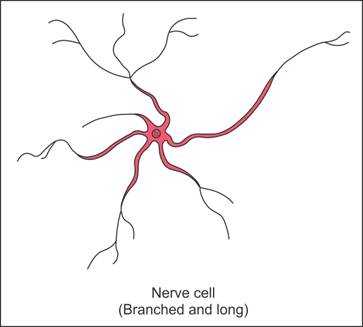 (b) Mesophyll Cells:
(b) Mesophyll Cells:
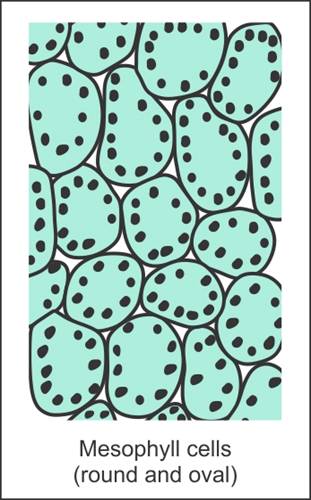
 (b) Mesophyll Cells:
(b) Mesophyll Cells:

Q22. Who proposed the fluid mosaic model of the plasma membrane? Describe
the detailed structure of the plasma membrane in eukaryotic cells.
Solution
Singer and Nicolson
proposed the fluid mosaic model of plasma membrane.
 The plasma membrane
is composed of a lipid bilayer.
The lipid molecules
are arranged in such a way that their polar head are towards the outer side
and the hydrophobic tails are on the inner side.
This arrangement of
lipid molecules ensures that the non-polar tail of hydrocarbons does not come
in contact with the aquatic environment present.
The proteins are of
two types. Integral proteins which are either partially or totally embedded
in the lipid bilayer and peripheral proteins which are present on the surface
of the membrane.
The quasi fluid nature of lipid enables
the lateral movements of proteins within the lipid bilayer.
The fluid nature of the membrane enables functions
such as cell growth, secretion, endocytosis, cell division and formation of the
intercellular junction.
The plasma membrane
is composed of a lipid bilayer.
The lipid molecules
are arranged in such a way that their polar head are towards the outer side
and the hydrophobic tails are on the inner side.
This arrangement of
lipid molecules ensures that the non-polar tail of hydrocarbons does not come
in contact with the aquatic environment present.
The proteins are of
two types. Integral proteins which are either partially or totally embedded
in the lipid bilayer and peripheral proteins which are present on the surface
of the membrane.
The quasi fluid nature of lipid enables
the lateral movements of proteins within the lipid bilayer.
The fluid nature of the membrane enables functions
such as cell growth, secretion, endocytosis, cell division and formation of the
intercellular junction.
 The plasma membrane
is composed of a lipid bilayer.
The lipid molecules
are arranged in such a way that their polar head are towards the outer side
and the hydrophobic tails are on the inner side.
This arrangement of
lipid molecules ensures that the non-polar tail of hydrocarbons does not come
in contact with the aquatic environment present.
The proteins are of
two types. Integral proteins which are either partially or totally embedded
in the lipid bilayer and peripheral proteins which are present on the surface
of the membrane.
The quasi fluid nature of lipid enables
the lateral movements of proteins within the lipid bilayer.
The fluid nature of the membrane enables functions
such as cell growth, secretion, endocytosis, cell division and formation of the
intercellular junction.
The plasma membrane
is composed of a lipid bilayer.
The lipid molecules
are arranged in such a way that their polar head are towards the outer side
and the hydrophobic tails are on the inner side.
This arrangement of
lipid molecules ensures that the non-polar tail of hydrocarbons does not come
in contact with the aquatic environment present.
The proteins are of
two types. Integral proteins which are either partially or totally embedded
in the lipid bilayer and peripheral proteins which are present on the surface
of the membrane.
The quasi fluid nature of lipid enables
the lateral movements of proteins within the lipid bilayer.
The fluid nature of the membrane enables functions
such as cell growth, secretion, endocytosis, cell division and formation of the
intercellular junction.
Q23. Which method of transport in the plasma membrane does not require a carrier molecule?
Solution
Neutral solutes can move across the plasma membrane along the concentration gradient by the process of simple diffusion. As the solutes move along the concentration gradient, a carrier is not required.
Q24. The core metal of chlorophyll is
Solution
Mg (magnesium) is the core metal of chlorophyll.
Chlorophyll contains a complex ring structure called a porphyrin ring.
Magnesium is present in the centre of this complex ring.
Q25. Mitochondria are semi-autonomous as they possess
Solution
Mitochondria
are semi-autonomous organelles.
For
replication and growth, they depend only partially on the cell.
They
have their own DNA, RNA and ribosomes and can make their own proteins.
Q26. Cellular totipotency was first demonstrated by
Solution
F. C. Steward and his co-workers conducted
experiments on carrot root tissues and were the first to demonstrate
totipotency.
Q27. State the four basic shapes of bacteria.
Solution
The four basic shapes of bacteria are bacillus, coccus, vibrio and
spirillum.
Q28. Cell theory was given by
Solution
M. J. Schleiden and
Theodore Schwann first put forward the cell theory in 1839.
The theory was
published in their paper ‘Microscopic Investigations on the Similarities of
Structure and Growth in Animals and Plants’.
Q29. Flagella of prokaryotic and eukaryotic cells differ in
Solution
Flagella of prokaryotic and eukaryotic species differ in microtubular organization and type of movement. In eukaryotes, the arrangement is 9+2 and specialized whereas in prokaryotes arrangement is 9+0 and is simple.
Q30. House-keeping
proteins occur in
Solution
House-keeping proteins are defined as
proteins which are required for the basic functioning of a cell.
Important enzymatic and structural
proteins are found in the endoplasmic reticulum, Golgi complex and
cytoskeleton of cells.
Q31. Name the largest cell.
Solution
Egg of an ostrich.
Q32. Tonoplast is the membrane surrounding the
Solution
The tonoplast is a single-layered
membrane which surrounds a vacuole.
It facilitates the
transport of ions and other materials from the cytoplasm to the vacuole.
Q33. What are mesosomes?
Solution
Mesosomes are essential infoldings of the cell membrane, a unique
characteristic of prokaryotic cells.
Q34. Which of the following is not a function of the cytoskeleton in a cell?
Solution
An elaborate network of a filamentous proteinaceous structure present in the cytoplasm is called cytoskeleton.
The cytoskeleton carries out functions such as mechanical support, motility and maintenance of the shape of the cell.
Q35. The largest subunit of prokaryotic ribosomes is
Solution
In prokaryotes, ribosomes are associated with the plasma membrane of the cell. They are made of two subunits - 50S and 30S units which when present together form 70S prokaryotic ribosomes.
Q36. Which of the following is present in both prokaryotic and eukaryotic
cells?
Solution
Prokaryotes have a 70S ribosome and eukaryotes have
an 80S ribosome.
Q37. The plasma membrane consists mainly of
Solution
The widely accepted fluid mosaic model of plasma
membrane suggests that the plasma membrane is composed of phospholipids
arranged in a bilayer. The plasma membrane also contains proteins on the
surface and partially or totally buried in a bilayer.
Q38. State the ratio of proteins and lipids of the plasma membrane of human
erythrocytes.
Solution
The plasma membrane of human erythrocytes contains 52%
of proteins and 40% of lipids.
Q39. Define tonoplast.
Solution
The tonoplast is the thin membrane which covers the vacuole.
Q40. Name the subunits of which a prokaryotic ribosome is made.
Solution
A prokaryotic ribosome is made of 50S and 30S subunits.
Q41. State the main component found in the middle lamella of the cell wall.
Solution
Calcium pectate is the main component found in the
middle lamella of the cell wall.
Q42. Write the significance of tonoplasts.
Solution
The tonoplast facilitates the transport of several ions and other
materials against the concentration gradient into the vacuole.
Q43. Ajay has understood that the important function of the plasma membrane is transport of molecules across the membrane. But he is confused with the processes such as diffusion, active transport, osmosis etc. Answer the following questions to help Ajay understand the various processes involved in the transport of molecules.
What is active transport?
What is osmosis?
Why movement of ions against the concentration gradient requires energy?
What values do you learn here?
Solution
Active transport - It is the movement of ions against their concentration gradient, i.e. from lower to higher concentration across the membrane. This process requires ATP and carrier proteins.
Osmosis - It is movement of water molecules from the region of their higher concentration to the region of their lower concentration through the plasma membrane.
Because the movement of ions occurs from the region of lower concentration to the region of higher concentration, it is against the normal flow of ions. The process needs energy.
The values we learn here are that every task should be completed by understanding its needs. To achieve success in difficult tasks, efforts and hardwork are important.
Q44. The site of protein synthesis is
Solution
Ribosomes use the mRNA as a template,
traverse each codon (3 nucleotides) of the mRNA and pair it with the
appropriate amino acid provided by tRNA. The amino acid chain elongates at
the ribosome and results in the formation of an appropriate protein.
Q45. Centrosomes are present
Solution
Centrosomes are
found in animal cells only. They help in the formation of spindle fibres
during the cell cycle.
In plant cells,
centrosomes are absent.
Q46. State the functions of the cell wall in a prokaryotic cell.
Solution
Functions of the cell wall in a prokaryotic cell are as follows:
It determines the shape of the cell.
It provides strong structural support to
prevent the cell from bursting or collapsing.
Q47. Nuclear membrane is absent in
Solution
Prokaryotes do not have a nuclear membrane. Nostoc is a prokaryote. Penicillium and Agaricus are fungi and Volvox is an alga; all three are eukaryotes.
Q48. State the function of the smooth endoplasmic reticulum.
Solution
The smooth endoplasmic reticulum is the major site for the synthesis
of lipids.
Q49. Name the two substances which are majorly produced in Golgi bodies.
Solution
Glycoproteins and glycolipids.
Q50. Explain the process of packaging of materials in the Golgi complex.
Solution
Materials which need to be packaged are in the form of vesicles.
These vesicles from the endoplasmic reticulum fuse with the cis face of the Golgi apparatus.
From the cis face, the material moves towards the maturing face, i.e. the trans face.
Q51. Mesosome in a bacterial cell is
Solution
Prokaryotic cells have a special membranous structure, mesosome, which is formed by the extensions of the plasma membrane into the cell. They help in cell wall formation, DNA replication and distribution to daughter cells. They also help in respiration, secretion processes and to increase the surface area of the plasma membrane and enzymatic content.
Q52. Cell theory is not applicable to
Solution
A virus is not considered as a living organism as it cannot grow.
A virus cannot replicate unless it infects a cell.
It then uses the host’s machinery for producing multiple copies of viruses.
Thus, even cell theory does not apply to viruses.
Q53. Which of the following is a prokaryote?
Solution
Amoeba is a
protozoan, Spirogyra and Chlamydomonas are algae; all three are eukaryotes.
Bacteria do not
have a well-defined nucleus and membrane-bound organelles are absent; thus, bacteria
are prokaryotes.
Q54. Three of the following statements regarding cell organelles are correct while one is wrong. Which one is wrong?
Solution
Lysosomes are single-membraned vesicles.
They bud off from the Golgi apparatus during the packaging process.
Lysosomes contain digestive enzymes capable of hydrolysing biological polymers.
Q55. Name the lipid component of the plasma membrane.
Solution
Phosphoglycerides form the lipid component of the plasma membrane.
Q56. Which one of the following structures between two adjacent cells is an
effective transport pathway?
Solution
The cell wall and middle lamellae may be traversed
by plasmodesmata which connects the cytoplasm of neighbouring cells and helps
in transport.
Q57. An enzyme which increases the rate of permeability across the plasma membrane is
Solution
Permeases act as transport proteins. They help in the transport of specific substances down their concentration gradient across the cell membrane.
Permeases thus help to increase the permeability of the membrane by transporting substances which were otherwise impermeable.
Q58. Draw the diagram of tracheid.
Solution
Tracheid:
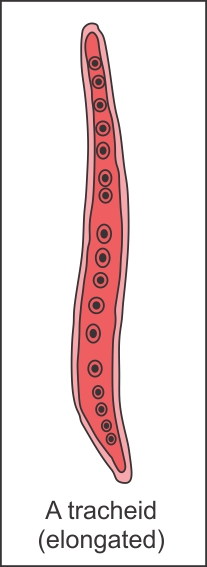

Q59. During endocytosis,
Solution
During endocytosis, the cell elongates its membrane and then engulfs and internalises the material.
This process is commonly used by Amoeba to obtain food from the surrounding.
Q60. The powerhouse of the cell is
Solution
Mitochondria convert the chemical energy found in glucose and other
nutrients in the presence of oxygen, resulting in formation of ATP molecules.
Thus, mitochondria are called powerhouses of a cell.
Q61. Draw a labelled diagram of the chloroplast and explain its structure.
Solution
Chloroplasts are oval, spherical, disc-shaped or ribbon-shaped.
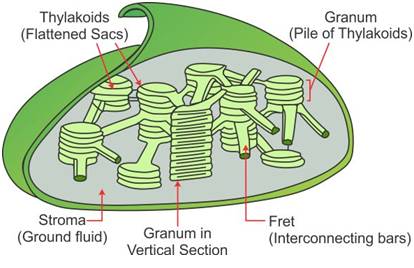 They are 5-10 mm in length and 2-4 mm in width.
It is a double-membraned organelle.
The space enclosed by the inner membrane is filled with a semi-solid substance called stroma.
Flattened, membranous sacks called thylakoids are present in the stroma.
The stroma contains several enzymes required for protein and carbohydrate synthesis, DNA, ribosomes and RNA.
The thylakoids are arranged like stacks of coins. These stacks are called grana.
Flat membranous tubules called stroma lamellae connect the thylakoids.
The thylakoids contain space within them called a lumen.
They are 5-10 mm in length and 2-4 mm in width.
It is a double-membraned organelle.
The space enclosed by the inner membrane is filled with a semi-solid substance called stroma.
Flattened, membranous sacks called thylakoids are present in the stroma.
The stroma contains several enzymes required for protein and carbohydrate synthesis, DNA, ribosomes and RNA.
The thylakoids are arranged like stacks of coins. These stacks are called grana.
Flat membranous tubules called stroma lamellae connect the thylakoids.
The thylakoids contain space within them called a lumen.
 They are 5-10 mm in length and 2-4 mm in width.
It is a double-membraned organelle.
The space enclosed by the inner membrane is filled with a semi-solid substance called stroma.
Flattened, membranous sacks called thylakoids are present in the stroma.
The stroma contains several enzymes required for protein and carbohydrate synthesis, DNA, ribosomes and RNA.
The thylakoids are arranged like stacks of coins. These stacks are called grana.
Flat membranous tubules called stroma lamellae connect the thylakoids.
The thylakoids contain space within them called a lumen.
They are 5-10 mm in length and 2-4 mm in width.
It is a double-membraned organelle.
The space enclosed by the inner membrane is filled with a semi-solid substance called stroma.
Flattened, membranous sacks called thylakoids are present in the stroma.
The stroma contains several enzymes required for protein and carbohydrate synthesis, DNA, ribosomes and RNA.
The thylakoids are arranged like stacks of coins. These stacks are called grana.
Flat membranous tubules called stroma lamellae connect the thylakoids.
The thylakoids contain space within them called a lumen.
Q62. Lysosomes contain
Solution
Lysosomes
contain enzymes which can digest all types of biological polymers - proteins,
nucleic acids, carbohydrates and lipids.
The
enzymes hydrolyse these polymers and break them down. Thus, lysosomes contain
hydrolytic enzymes.
Q63. Describe the two types of membrane proteins.
Solution
Two types of membrane proteins are as follows:
Integral membrane proteins: They are partially
or totally buried in the membrane.
Peripheral membrane proteins: They are present
on the surface of the membrane.
Q64. Write the functions of the cytoskeleton.
Solution
Functions of cytoskeleton:
It provides mechanical support and motility to the cell.
It maintains the shape of the cell.
Q65. Which of the following organelles does not have a membrane?
Solution
Ribosomes are composed of RNA and proteins and are not surrounded by any membrane.
The nucleus, chloroplasts and mitochondria, all are surrounded by a double-layered membrane.
Q66. Name the membranous extension other than the mesosome which is found
in cyanobacteria.
Solution
Chromatophores
Q67. Which one of these is not a eukaryote?
Solution
Euglena and
Spirogyra are algae, Agaricus is a fungus; all three are eukaryotes.
Anabaena is a
cyanobacterium, a prokaryote. It can carry out photosynthesis and nitrogen
fixation.
Q68. Distinguish between metacentric and submetacentric chromosomes.
Solution
Metacentric Chromosome
Sub-metacentric Chromosome
Centromere is located centrally.
Centromere is slightly away from the centre of the chromosome.
Both the arms are equal.
One arm is shorter and one arm is longer.
Q69. Distinguish between rough endoplasmic reticulum and smooth endoplasmic
reticulum.
Solution
Rough Endoplasmic Reticulum
Smooth Endoplasmic Reticulum
It
is the site of protein synthesis and secretion.
It
is the site of lipid synthesis.
Ribosomes
are present on their surface.
Ribosomes
are absent.
Q70. What are the three layers bound by the cell envelope in prokaryotic
cells?
Solution
The three layers bound by the cell envelope in prokaryotic cells are
the outer glycocalyx, the middle cell wall and the inner plasma membrane.
Q71. Draw a diagram of an animal cell and label any six parts.
Solution
Animal Cell:


Q72. Long, flattened and usually unbranched units arranged in parallel
stacks in the endoplasmic reticulum are called
Solution
The endoplasmic reticulum forms tubes known as
cisternae.
These tubes are an interconnected network of
flattened, membrane-enclosed sacs or tubes.
Q73. Name the structure which is responsible for excretion in Amoeba.
Solution
The contractile vacuole is responsible for excretion in Amoeba.
Q74. State the function of the primary cell wall found in young plants.
Solution
The function of the primary cell wall found in young
plants is growth.
Q75. Name the pigments which impart the following colour to plants, flowers
or fruits.
Orange
Yellow
Green
White/Colourless
Solution
Orange - Carotene
Yellow - Xanthophyll
Q76. Write the name of the structure which connects the cytoplasm of two
cells.
OR
Name the structure which traverses the cytoplasm and the middle
lamella to connect two neighbouring cells through their cytoplasm.
Solution
Plasmodesmata connect the cytoplasm of two cells.
Q77. Name any one cell organelle which is not bound by the membrane.
Solution
Ribosome
Q78. What is the main arena of the cell and state its function.
Solution
The cytoplasm is the main arena of the cell, and it is the site for many metabolic activities which occur within the cell.
Q79. Define cytoskeleton.
Solution
The cytoskeleton is the network of filamentous proteinaceous
structures present in the cytoplasm.
Q80. Name the plastids which store proteins.
Solution
Aleuroplasts
Q81. Name the process by which water moves across the cell membrane.
Solution
Water moves across the membrane by osmosis.
Q82. When is the glycocalyx called a slime layer?
Solution
The glycocalyx is called a slime layer when it is in the form of a loose sheath.
Q83. State the name of the scientists who observed ribosomes under an electron
microscope for the first time.
Solution
George Palade observed ribosomes under an electron microscope for the
first time.
Q84. What is true about ribosomes?
Solution
Ribosomes are found in both prokaryotic and eukaryotic cells. Prokaryotes have 70S ribosomes and eukaryotes have 80S ribosomes.
Ribosomes are composed of 32-67% RNA and the rest are proteins.
Q85. Which is the longest cell?
Solution
Nerve cell is the longest cell.
Q86. What are the structures called which give an appearance as beads on a string
in the chromosomes when viewed under an electron microscope?
Solution
Nucleosomes are
particles present on the chromatin fibre which give a beaded appearance to
the chromatin.
A nucleosome
consists of a DNA which wraps a histone octamer.
Q87. State the arrangement of microtubules found in cilia and flagella.
Solution
9 + 2
Q88. Name any two carotenoid pigments.
Solution
The carotenoid pigments are xanthophyll and carotene.
Q89. Describe the general structure of a prokaryotic cell.
Solution
A prokaryotic cell consists of the cell wall which surrounds the cell
membrane.
The interior of the cell is filled with a matrix called cytoplasm.
A well-defined nucleus is absent. The genetic material is naked and
not enclosed in a nuclear membrane.
Prokaryotic cells show the presence of extra-chromosomal DNA called
plasmid.
The cell membrane shows some extension in the cytoplasm called
mesosomes.
These cells show the presence of ribosomes.
Q90. Draw a diagram of the acrocentric chromosome and describe its structure.
Solution
The acrocentric chromosome has the centromere situated at one end.
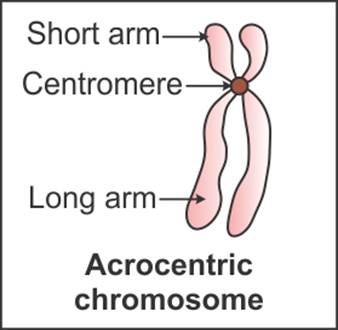 Its one arm is extremely long and other arm is extremely short.
Its one arm is extremely long and other arm is extremely short.
 Its one arm is extremely long and other arm is extremely short.
Its one arm is extremely long and other arm is extremely short.
Q91. What does ‘S’ from 70S stand for?
Solution
The ‘S’ (Svedberg unit) from 70S stands for sedimentation coefficient.
Q92. From the following statements, select the statement that is true:
Solution
Animal cells lack a cell wall.
All eukaryotic cells except amoeba and slime moulds contain microtubules.
The Golgi apparatus is present in all eukaryotic cells.
Chloroplasts are found in plant cells. Some prokaryotes (e.g. cyanobacteria) contain chlorophyll, but chloroplast is absent. Animal cells also lack chloroplasts.
Q93. Name the part of the cell wall which helps neighbouring cells to bind
together.
Solution
The middle lamella helps neighbouring cells to bind
together.
Q94. Who explained the concept Omonis cellula e cellula?
Solution
Rudolf Virchow explained the concept Omonis cellula e cellula.
Q95. Chlorophyll in chloroplasts is located in
Solution
Stroma
is the space enclosed within the membranes in the chloroplast. Stroma
contains several flat membranous sacs called thylakoids. Chlorophyll is present in the thylakoids. Thylakoids
are arranged in stacks like the piles of coins called grana.
Q96. Draw a well-labelled diagram of the chloroplast.
Solution
Chloroplast:


Q97. State the function of the rough endoplasmic reticulum.
Solution
The rough endoplasmic reticulum is involved in protein synthesis and
secretion.
Q98. Name the smallest cell found.
Solution
Mycoplasma
Q99. State the postulates of the cell theory.
Solution
Cell Theory:
All living organisms are composed of cells and
are products of cells.
All cells arise from pre-existing cells.
Q100. Represent the centromere and kinetochore diagrammatically.
Solution
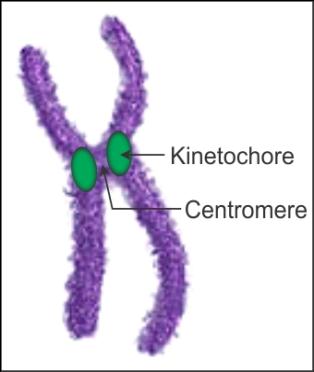
Q101. What are inclusion bodies? Write the names of the inclusion bodies
found in prokaryotic cells.
Solution
Inclusion bodies are the reserve materials stored in the cytoplasm of
prokaryotic cells.
The following inclusion bodies are found in prokaryotic cells: Phosphate
granules, cyanophycean granules and glycogen granules.
Q102. Name the scientist who described the nucleus for the first time.
Solution
Robert Brown described the nucleus for the first time.
Q103. Name the two cells which lack a nucleus.
Solution
The cells which lack a nucleus are as follows:
Mammalian erythrocytes
Sieve tube cells of vascular plants
Q104. Distinguish between active transport and osmosis.
Solution
Active
Transport
Osmosis
Movement
of ion occurs against the concentration gradient, i.e. from lower to
higher concentration.
Movement
of water molecules occurs across the concentration gradient, i.e. from
higher to lower concentration.
Carrier
proteins are required to facilitate the movement of ions.
Carrier
proteins are not required.
ATP
is utilised for the transport of ions across the membrane.
Energy
is not required.
Q105. Draw a diagram of a mitochondrion and label any four parts.
Solution
Mitochondrion:


Q106. State the compartments of the intracellular space formed due the
endoplasmic reticulum.
Solution
The two compartments of the intracellular space formed due the
endoplasmic reticulum are
Luminal compartment
Extraluminal compartment
Q107. Name the organelles which are collectively known as the endomembrane
system.
Solution
The endoplasmic reticulum, Golgi complex, lysosomes and vacuoles are
collectively known as the endomembrane system.
Q108. Write the names of any four prokaryotic cells.
Solution
Blue-green algae
Mycoplasma
PPLO (Pleuro-Pneumonia-Like Organisms)
Bacteria
Q109. Who discovered the cell nucleus?
Solution
Robert Brown discovered the cell nucleus.
Q110. Mitochondria are called power houses of the cell. Justify.
Solution
Mitochondria are the sites of aerobic respiration. They produce
cellular energy in the form of ATP. Hence, they are called powerhouses of the
cell.
Q111. Give the significance of the following:
Quasi fluid nature of lipid
The fluid nature of the membrane
Solution
Quasi fluid nature of lipid: It enables the lateral movement of proteins within the lipid bilayer.
The fluid nature of the membrane: It enables functions such as cell growth, secretion, endocytosis, cell division and formation of intercellular junction.
Q112. Write the expanded form of PPLO.
Solution
PPLO - Pleuro-Pneumonia-Like Organisms
Q113. Draw a diagram of the Golgi apparatus and describe its structure.
Solution
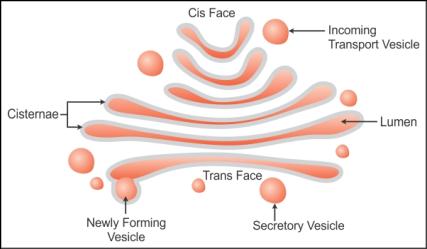 The Golgi apparatus consists of sac-like structures called cisternae which are flat, disc-shaped. The cisternae are of 0.5-1.0 m.
Cisternae are concentrically arranged near the nucleus.
The convex face of cisternae is called cis which is also known as the forming face.
The concave face of cisternae is called trans which is also known as the maturing face.
The two faces of the Golgi apparatus are different from each other, but they are interconnected.
The Golgi apparatus consists of sac-like structures called cisternae which are flat, disc-shaped. The cisternae are of 0.5-1.0 m.
Cisternae are concentrically arranged near the nucleus.
The convex face of cisternae is called cis which is also known as the forming face.
The concave face of cisternae is called trans which is also known as the maturing face.
The two faces of the Golgi apparatus are different from each other, but they are interconnected.
Q114. Define cell.
Solution
The cell is the fundamental structural and functional unit of all
living organisms.
Q115. Define polysome.
Solution
The polysome is a structure formed when
several ribosomes attach to a single-stranded mRNA to form a chain.
Q116. What was the drawback of the cell theory proposed by Schleiden and
Schwann?
Solution
The cell theory which was explained by Schleiden and Schwann could not
explain how new cells were formed.
Q117. Write the two important characteristics of unicellular organisms.
Solution
Two important characteristics of unicellular organisms are as follows:
They show independent existence.
They are capable of performing all essential functions
of life.
Q118. Explain the structure of a centrosome.
Solution
The centrosome consists of two
centrioles which lie perpendicular to each other.
Each centriole has a cart-wheel-like
organisation.
Each centriole is made of nine
peripheral tubulin fibrils which are evenly spaced.
Each of the peripheral fibrils is a
triplet. The adjacent triplets are linked.
The central part of the proximal region of each centriole is called a hub.
The hub is connected to peripheral
triplets by proteinaceous spokes.
Q119. Name the following:
Chromosome with the centromere located
terminally
Non-staining secondary constrictions in some
chromosomes
Component of the nucleus which is stained by
basic dyes
Solution
Chromosome with the centromere located
terminally: Telocentric chromosome
Non-staining secondary constrictions in some
chromosomes: Satellite
Component of the nucleus which is stained by
basic dyes: Chromatin
Q120. State the functions of mesosomes.
Solution
Functions of mesosomes:
Mesosomes help in cell wall formation.
They also help in DNA replication and distribution to daughter cells.
They help in respiration, secretion and to increase the surface area of the plasma membrane and the enzyme content.
Q121. Explain the arrangement of microtubules in cilia and flagella.
Solution
A cilium or flagellum is covered with the plasma membrane.
Its core is known as axoneme.
The axoneme consists of nine pairs of doublets of radially arranged
peripheral microtubules.
A pair of microtubules is located centrally.
Such an arrangement of microtubules in the axoneme is referred to as the
9 + 2 array.
The central microtubules are connected to each other by a bridge, and
they are enclosed by a central sheath.
The central sheath is connected to one of the peripheral tubules from
each doublet by nine spokes.
Q122. Who discovered Golgi bodies?
Solution
Camillo Golgi discovered Golgi bodies.
Q123. Who coined the term chromatin?
Solution
Flemming coined the term chromatin.
Q124. Who proposed the fluid mosaic model of the cell membrane?
Solution
Singer and Nicolson proposed the fluid mosaic model
of the cell membrane.
Q125. Represent diagrammatically the internal structure of a
cilium/flagellum.
Solution
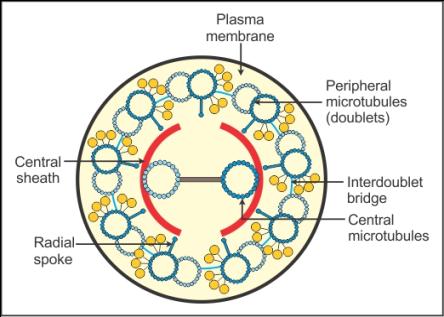
Q126. Define endoplasmic reticulum.
Solution
The endoplasmic reticulum is a network of tiny tubular structures
scattered in the cytoplasm.
Q127. Name the following:
Plastids which store oil
Plastids which store proteins
Plastids which store starch
Solution
Plastids which store oil - Elaioplasts
Plastids which store proteins - Aleuroplasts
Plastids which store starch - Amyloplasts
Comments
Post a Comment